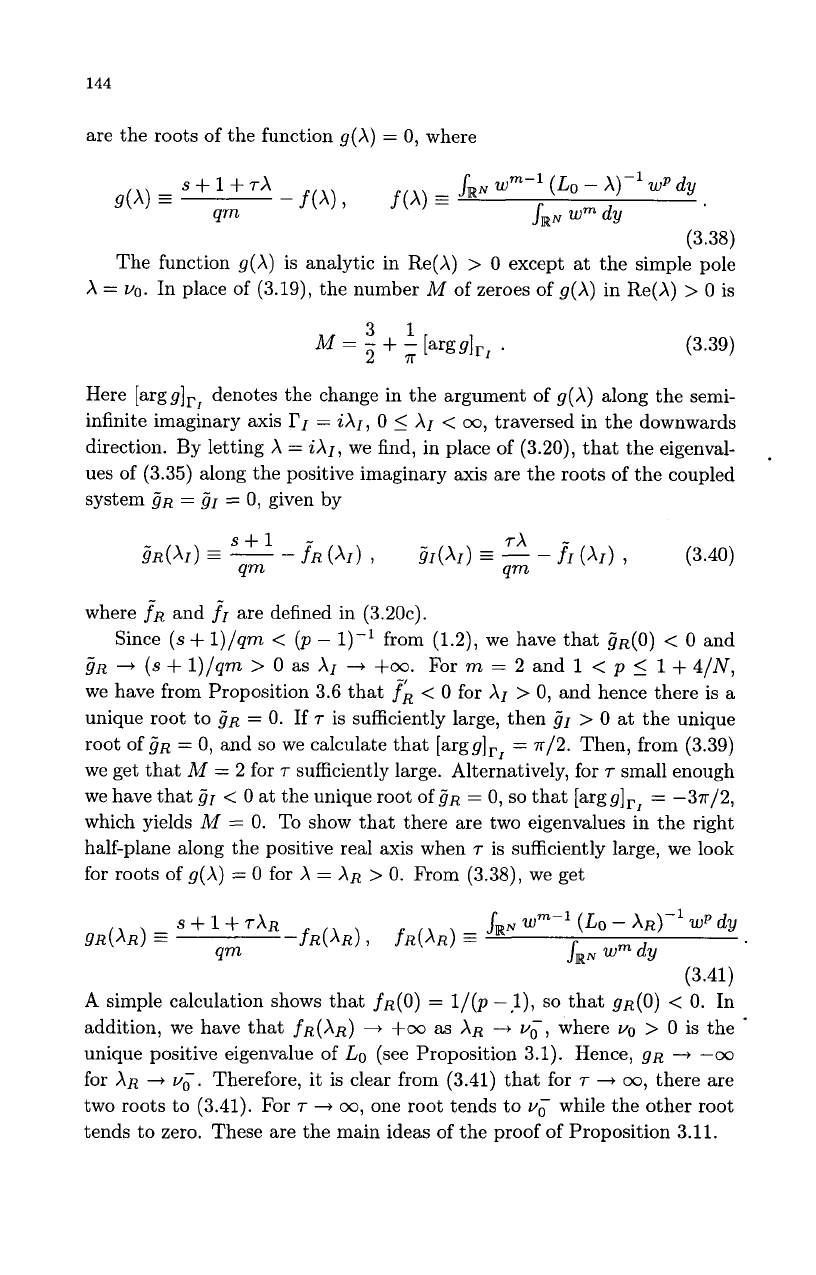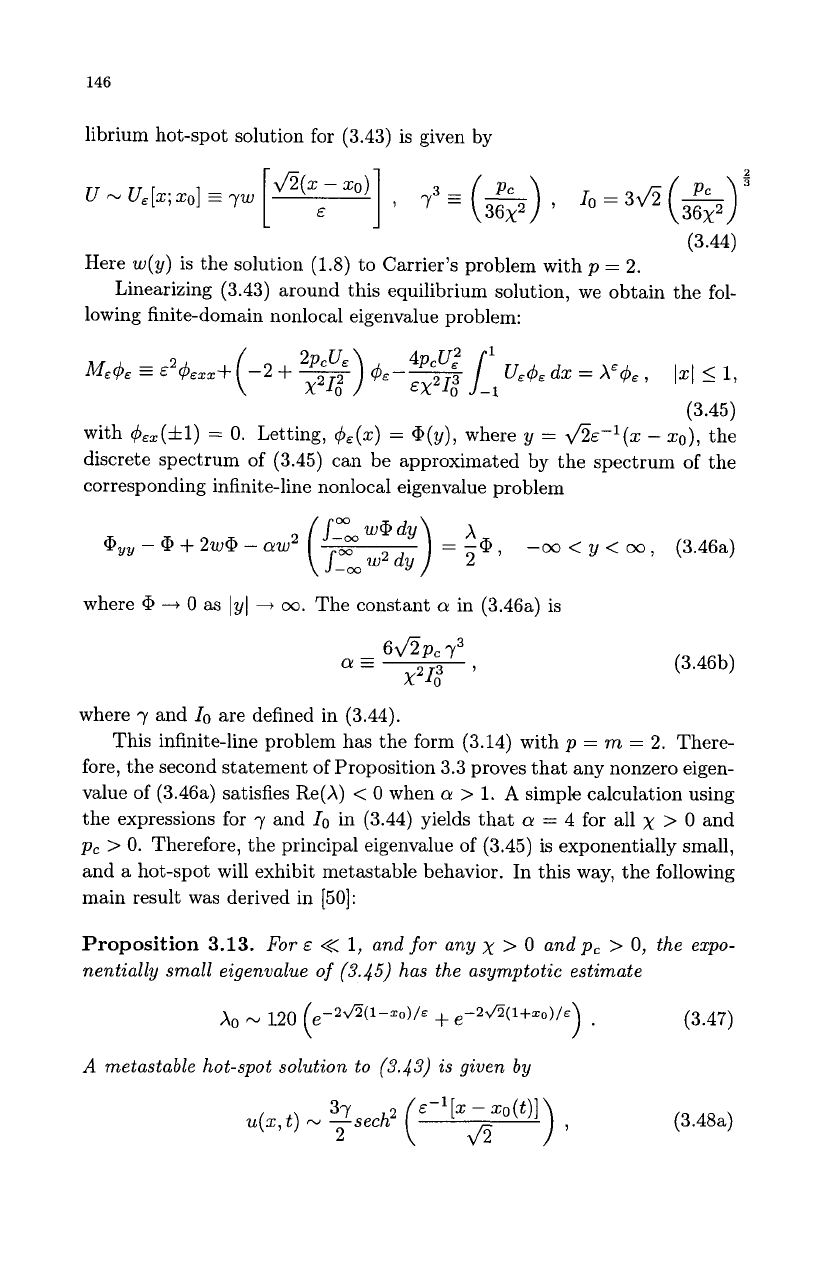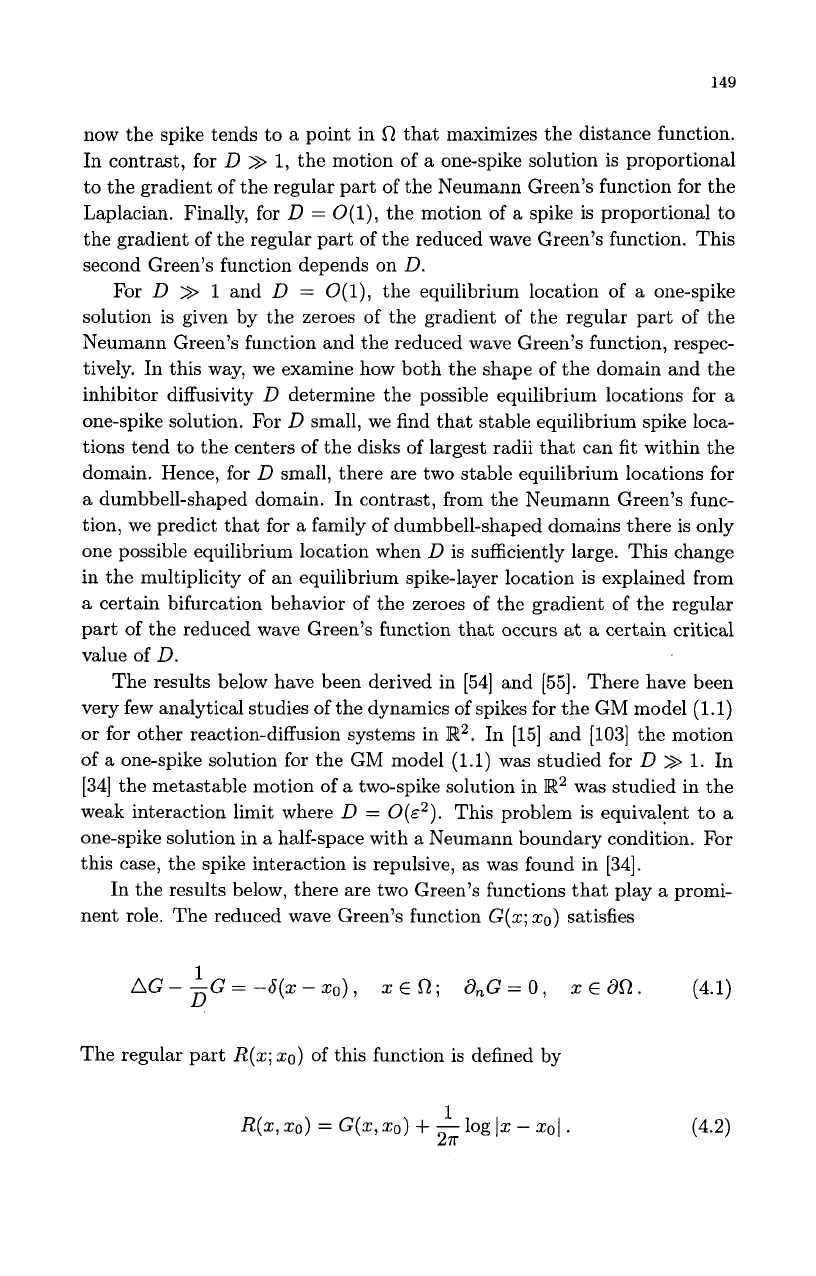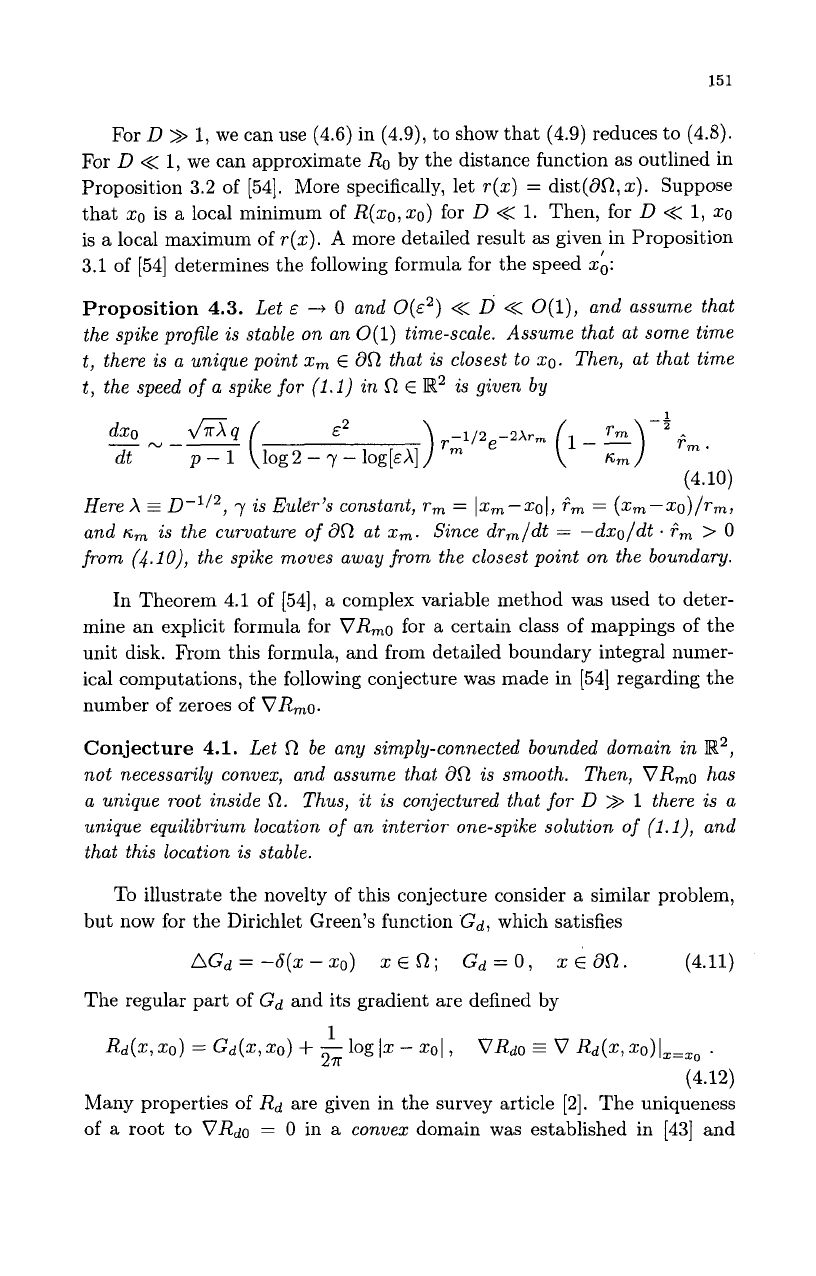Hua C., Wong R. Differential Equations and Asymptotic Theory in Mathematical Physics
Подождите немного. Документ загружается.


142
we obtain the following nonlocal eigenvalue problem in place of (3.28):
where
@
-+
0
as
IyI
-+
co
and
LO
is defined in (3.14b). This eigenvalue
problem is more complicated than (3.28) since the multiplier of the nonlocal
term now depends on
rX.
The spectrum of (3.35) was studied in [106], where the following result
was obtained.
Proposition
3.11.
Assume that
m
=
2
and
1
<
p
5
1
+4/N.
Then, there
exists a unique
r
=
TO
>
0
such that
(3.35)
has an eigenvalue
X
=
iX:,
with
A:
>
0.
For all
r
>
TO
there are exactly two eigenvalues
of
(3.35)
in
the
right
half-plane Re(X)
>
0.
In addition, there exists a
rc
with
rc
>
70
such
that for any
r
with
r
>
r,,
these two eigenvalues are on the positive real
axis, with one eigenvalue tending to
vo
and the other eigenvalue tending to
zero as
r
-i
00.
Here
vo
>
0
is the unstable eigenvalue
of
the local operator
LO.
Alternatively,
for
any
r
with
0
<
r
<
TO
there are no eigenvalues
of
(3.35)
in
the
right
half-plane.
The existence of a complex conjugate pair of eigenvalues for some
r
=
70
was proved in Theorem
2.3
of [106]. The remainder of the proposition was
proved in Lemma 3.1 and in Sec.
3
of [106]. Since there are no eigenvalues
in the left half-plane when
0
<
r
<
70
and exactly two when
r
>
70,
this
result shows a transversal crossing condition for
r
near
TO
and proves the
existence of a Hopf bifurcation point. In Lemma 2.5 and
Eq.
(2.36) of [106],
the following bounds on the frequency
Proposition
3.12.
Assume that
m
=
2
and
1
<
p
5
1
+
4/N.
Let
C
and
CN,~
be defined
by
were derived:
N
+
(p
+
1)
(1
-
N/2)
<=--
2q
(s+
1)
>
0.
(3.36)
P-1
cN,p
Then, the Hopf bifurcation values
TO
and
A:
>
0
satisfy
For the exponent set
(p,q,p,s)
=
(2,1,2,0), in Fig. 7 we illustrate
Proposition (3.11) by plotting the path of
X
=
XR
+
iX1
as
r
is increased.
This type of path in the spectrum is very similar to what was shown for

143
1.0
0.5
o,ol..#
........
)7
..
1.
-0.5
-1.0
-1.5
-2.0
-1.0 -0.5
0.0
0.5 1.0 1.5
2.0
AR
Figure
7.
Plot of the path of
X
=
AR
f
iAI
for
(p,
q,
m,
s)
=
(2,1,2,0)
with
N
=
2
(arrows indicate direction of increasing
T).
There is a pair of pure imaginary eigenvalues
when
T
=
TO.
The complex conjugate pair merge onto the real axis at
A:
when
7
=
rC.
For
T
>
T~,
one eigenvalue then tends to the eigenvalue
vo
>
0
of
Lo
as
T
+
00.
the
GS
model in one spatial dimension in
[25]
and
[26].
The existence of
two real positive eigenvalues for
T
>>
1
was proved in
[16].
In Table
1
we give some numerical results for
TO
and
A:,
obtained from
full numerical solutions of
(3.35)
for different exponent sets
(p,
q,
m,
s)
and
dimension
N.
The lower and upper bounds on
A?
predicted in
(3.37)
are
also shown. Notice that the lower bound is actually quite close to the
numerically computed value.
Table
1.
Numerical values for
TO,
A?,
and
T~
for
different exponent sets
(p,
q,
m,
s)
and dimension
N
for which
m
=
2
and
1
<
p
5
1
+
4/N.
The
lower and upper bounds for
A?
given in
(3.37)
are given in the fifth and sixth
columns.
(PrqIm,S)
N
TO
A:
(lower bound) (upper bound)
T~
(2,1,2,0)
1
0.771
1.238 1.200 2.484
4.560
(2,1,2,0)
2 0.561
1.593 1.500 3.230
3.338
(2,1,2,0)
3
0.373 2.174
2.000 4.519
2.189
(3,2,2,0)
1 0.304 2.859
2.667 5.842
1.800
(3,2,2,0)
2 0.150
4.477 4.000 9.849
0.843
(4,2,2,0)
1 0.149 2.525
2.143 6.628
0.471
We now discuss
a
few of the ideas that are needed for the proof of
Proposition
3.11.
As
in the derivation of
(3.18),
the eigenvalues of
(3.35)

144
are the roots of the function g(X)
=
0,
where
(3.38)
The function g(X) is analytic in Re(X)
>
0
except at the simple pole
X
=
VO.
In place of
(3.19),
the number
M
of zeroes of g(X) in Re(X)
>
0
is
31
27r
M
=
-
+
-
[argglrr
.
(3.39)
Here [arggIrr denotes the change in the argument of g(X) along the semi-
infinite imaginary axis
I'I
=
iXI,
0
5
XI
<
00,
traversed in the downwards
direction. By letting
X
=
iXI,
we find, in place of
(3.20),
that the eigenval-
ues of
(3.35)
along the positive imaginary axis are the roots of the coupled
system
ij~
=
51
=
0,
given by
I
where
f~
and
f~
are defined in
(3.20~).
Since
(s
+
l)/qm
<
(p
-
1)-l
from
(1.2),
we have that
ij~(0)
<
0
and
ij~
-+
(s
+
1)/qm
>
0
as
XI
-+
+co.
For
m
=
2
and
1
<
p
5
1
+
4/N,
we have from Proposition
3.6
that
f;
<
0
for
XI
>
0,
and hence there is a
unique root to
ij~
=
0.
If
r
is sufficiently large, then
ij~
>
0
at
the unique
root of
ij~
=
0,
and
so
we calculate that [argglrr
=
n/2.
Then, from
(3.39)
we get that
M
=
2
for
T
sufficiently large. Alternatively, for
T
small enough
we have that
ij~
<
0
at the unique root
Of
ij~
=
0,
so
that [argglrr
=
-37r/2,
which yields
A4
=
0.
To show that there are two eigenvalues in the right
half-plane along the positive real axis when
T
is sufficiently large, we
look
for roots of
g(X)
=
0
for
X
=
XR
>
0.
From
(3.38),
we get
(3.41)
A
simple calculation shows that
f~(0)
=
l/(p
-l),
so
that gR(0)
<
0.
In
addition, we have that
~R(XR)
+
+a
as
XR
-+
YO,
where
vo
>
0
is the
unique positive eigenvalue of
Lo
(see Proposition
3.1).
Hence, gR
-+
-co
for
XR
-+
YO.
Therefore, it is clear from
(3.41)
that for
T
-+
co,
there are
two roots to
(3.41).
For
T
-+
co,
one root tends to
VO
while the other root
tends to zero. These are the main ideas of the proof of Proposition
3.11.

145
Question
3.8.
Can one determine more general conditions on the expo-
nents
(p,
q,
m,
s)
and on
N
for the existence of a unique Hopf bifurcation
point for
r
>
O?
Question
3.9.
Analyze the large-scale oscillatory motion for
(3.25)
for val-
ues of
T
well-beyond the Hopf bifurcation point. Using a weakly nonlinear
analysis determine whether the Hopf bifurcation is subcritical
or
supercrit-
ical. In the presence of the fast oscillation, derive an ODE for the slow
motion of the center of the spike.
Is
the drift still exponentially slow?
3.3.
A
Microwave Heating Model
Another problem where nonlocal singularly perturbed PDE’s arise is in the
study
of
hot-spot formation in the microwave heating of ceramics (cf.
[62],
[63], [9],
[lo],
and
[ll]).
As shown in
[62],
when a thin cylindrical ceramic
sample is placed in
a
resonant single-mode microwave cavity in such a way
that the intensity
of
the electric field is constant along the axis of the
cylinder,
a
localized region
of
elevated temperature, known as a hot-spot,
can arise. The mechanism for the formation of a stable hot-spot is the
detuning of the cavity that occurs
as
a result of a large increase in the
electrical conductivity of the sample for high temperatures. Depending
on the parameters, this detuning shifts the resonant point of the cavity,
which reduces the strength of the electric field, and thereby stabilizes the
temperature profile. In the small Biot number limit, and for a thin sample,
the modeling of this detuning effect leads to
a
nonlocal reaction-diffusion
equation for the dimensionless temperature
u(z,t)
along the axis of the
sample of the form (cf.
[62]):
’
2
7
1x1
5
17
Pcf
(u)
ut
=
&zuXx
-
2
(u
+
qu
+
114
-
11)
+
1
+
x2
[t1
f(u)
dz]
(3.42)
with
u,
=
0
at
z
=
*l.
Here
E
<<
1,
x
>
0,
p,
>
0,
and
b
<<
1,
and
f(u)
is
An equilibrium hot-spot solution has
u
-+
00
as
E
-+
0.
The appropriate
rescaling is
u
=
E-~/~U
with
U
=
O(1)
as
derived in
[9].
Using this rescaling
in
(3.42),
and with
b
<<
O(E~),
we obtain the following rescaled problem
electrical conductivity
of
the sample, which is modeled as
f(u)
=
1
+
u
2
.
1x1
5
1;
Ux(fl,t)
=
0,
(3.43)
PCU2
u,
=
E2Uxx
-
2u
+
-
X2Ii
’
where
10
=
E-~
J:l
U2
dz.
This problem has the form in
(3.7).
The equi-

146
librium hot-spot solution for (3.43) is given by
(3.44)
Here
w(y)
is the solution
(1.8)
to Carrier's problem with
p
=
2.
lowing finite-domain nonlocal eigenvalue problem:
Linearizing (3.43) around this equilibrium solution, we obtain the fol-
(3.45)
with
&Z(&l)
=
0.
Letting,
&(x)
=
@(y),
where
y
=
&~-l(x
-
ICO),
the
discrete spectrum of (3.45) can be approximated by the spectrum of the
corresponding infinite-line nonlocal eigenvalue problem
ayy
-
cp
+
2wa
-
CYw2
=
5@
,
-00
<
y
<
00
(3.46a)
where
@
-+
0
as
IyI
+
00.
The constant
a
in (3.46a) is
6JzPc
y3
x2G
a=
(3.46b)
where
y
and
I0
are defined in (3.44).
This infinite-line problem has the form (3.14) with
p
=
m
=
2.
There-
fore, the second statement of Proposition 3.3 proves that any nonzero eigen-
value of (3.46a) satisfies Re(X)
<
0
when
a
>
1.
A
simple calculation using
the expressions for
y
and
10
in (3.44) yields that
CY
=
4 for all
x
>
0
and
p,
>
0.
Therefore, the principal eigenvalue of (3.45) is exponentially small,
and
a
hot-spot will exhibit metastable behavior. In this way, the following
main result was derived in [50]:
Proposition
3.13.
For
E
<<
1,
and
for
any
x
>
0
and
p,
>
0,
the expo-
nentially small eigenvalue
of
(3.45)
has the asymptotic estimate
(3.47)
1.
xo
120
(e-2\/5(1-ZO)/E
+
e--2\/5(l+ZO)/E
A
metastable hot-spot solution to (3.43) is given by
(3.48a)

147
where the hot-spot location
xo
(t)
satisfies the differential equation,
(3.48b)
This shows that the equilibrium hot-spot solution centered at
xo
=
0 is
unstable, and that the hot-spot tends to the closest of the two boundaries.
As
a remark,
a
similar analysis can be done for the generalized polynomial
conductivity model
f(u)
=
1
+
qup.
In place of
(3.46a),
the corresponding
finite-domain nonlocal eigenvalue problem is
The only result for the spectrum of this problem is given in the third state-
ment of Proposition 3.3.
Question
3.10.
Can a similar analysis be done for (3.49) and for the
multi-dimensional version of (3.42)?
3.4.
A
Flame-Bent
Evolution
Model
This problem concerns the evolution of
a
flame-front in a vertical channel.
For
a
channel with a constant cross-section
R
in the
x
=
(XI
,
x2)
plane, and
under certain physical conditions, the flame-front interface
z
=
Z(x1
,
22,
t)
satisfies the nonlocal
PDE
(cf. [7], [92])
Here
E
<<
1,
101
is the area
of
the cross-section and
d,
is the outward
normal derivative. It is observed in physical experiments and numerical
computations that the flame-front interface assumes a roughly paraboloidal
shape and that the tip of the paraboloid moves very slowly.
The simpler one-dimensional problem in the slab geometry
R
=
[0,1]
was studied in [7] and [92] by first converting
(3.50)
into
a
local problem
by using the transformation
w
=
-Zx.
This yields a convection-diffusion
problem known
as
the Burgers-Sivashinsky equation
Vt
+
ww,
-
w
=
&Wzx
,
v(0,
t)
=
v(1,
t)
=
0. (3.51)

148
By analyzing
(3.51),
it was shown in
[92]
that the tip
xo
=
xo(t) of a
parabolic flame-front interface drifts exponentially slowly towards the clos-
est point on the channel wall (i.e. either x
=
0
or x
=
1)
according to the
ODE
The simple substitution
=
-2,
to eliminate the nonlocal term for the
one-dimensional case has no counterpart for the two-dimensional problem
(3.50).
However, the change of variables
2
=
2E
logu,
(3.53)
readily reduces
(3.50)
to the nonlocal problem
which is a special case of
(3.7).
The corresponding local steady-state prob-
lem is
EAU
+
u
log
u
=
0,
which has a degenerate nonlinearity of the type
studied in
[21].
This leads to the following question:
Question
3.11.
Can one analyze
(3.54)
and the spectrum of the linearized
problem? In one-dimension, can one use
(3.54)
to give
a
rigorous proof
of
(3.52).
Can the two-dimensional problem for
a
paraboloidal-shaped
interface be analyzed? Investigate spike equilibria for Carrier's problem
E'U"
+
u
log
u
=
0,
and its multi-dimensional counterpart.
4.
Dynamics and Equilibria
of
a Spike in an R-D System
We begin this section by giving some results for the dynamics and equi-
librium locations for an interior one-spike solution to the
GM
model
(1.1)
with
r
=
0
in a bounded domain
R
E
&I2.
The results in this section cover
the range
D
>>
O(E'),
where
D
is not exponentially large
as
E
-+
0.
The
near-shadow limit where
D
=
O(e"/')
for some
c
>
0
is discussed in
55.1.
Even in the simple case where
r
=
0,
there are different dynamical laws
of spike motion that hold for different ranges of
D.
For the shadow problem
where
D
=
00,
we found above in Proposition
3.8
that
a
one-spike solution is
metastable and that the spike drifts exponentially slowly towards the closest
point on
do.
Alternatively, for
D
small with
E'
<<
D
<<
1,
we find below
that the motion
of
an interior one-spike solution is again metastable, but

149
now the spike tends to a point in
R
that maximizes the distance function.
In contrast, for
D
>>
1,
the motion of a one-spike solution is proportional
to the gradient of the regular part of the Neumann Green’s function for the
Laplacian. Finally, for
D
=
0(1),
the motion of
a
spike is proportional to
the gradient of the regular part of the reduced wave Green’s function. This
second Green’s function depends on
D.
For
D
>>
1
and
D
=
0(1),
the equilibrium location of a one-spike
solution is given by the zeroes of the gradient of the regular part of the
Neumann Green’s function and the reduced wave Green’s function, respec-
tively. In this way, we examine how both the shape of the domain and the
inhibitor diffusivity
D
determine the possible equilibrium locations for a
one-spike solution. For
D
small, we find that stable equilibrium spike loca-
tions tend to the centers of the disks of largest radii that can
fit
within the
domain. Hence, for
D
small, there are two stable equilibrium locations for
a dumbbell-shaped domain. In contrast, from the Neumann Green’s func-
tion, we predict that for
a
family of dumbbell-shaped domains there is only
one possible equilibrium location when
D
is sufficiently large. This change
in the multiplicity of an equilibrium spike-layer location is explained from
a
certain bifurcation behavior of the zeroes of the gradient of the regular
part of the reduced wave Green’s function that occurs
at
a
certain critical
value of
D.
The results below have been derived in
[54]
and
[55].
There have been
very few analytical studies of the dynamics of spikes for the GM model (1.1)
or for other reaction-diffusion systems in
R2.
In
[15]
and [lo31 the motion
of
a
one-spike solution for the GM model
(1.1)
was studied for
D
>>
1. In
[34] the metastable motion of a two-spike solution in
R2
was studied in the
weak interaction limit where
D
=
O(E~).
This problem is equivalent to a
one-spike solution in
a
half-space with a Neumann boundary condition. For
this case, the spike interaction is repulsive,
as
was found in [34].
In the results below, there are two Green’s functions that play
a
promi-
nent role. The reduced wave Green’s function
G(z;
zo)
satisfies
1
D
AG
-
-G
=
-d(z
-
ZO)
,
z
E
R;
&G
=
0,
z
E
do.
(4.1)
The regular part
R(z;
20)
of this function is defined by

150
Alternatively, the Neumann Green's function
G,
(x;
XO)
satisfies
1
AG
---~(x-xo),
~€0;
&G,=O,
XE~R;
Gmdx=O.
(4.3)
(4.4)
VRO
V~R(X,ZO)I,.,~
VRmo
3
VzRm(x,xo)Iz.zo
.
(4.5)
-
If4
s,
The regular part
R,
of this Green's function is defined by
1
Rm(x,
20)
=
-
21T
log
IX
-
50)
+
Gm(x,
20).
In terms of
R
and
R,,
we define
Ro
E
R(x0,
XO)
and
For
D
>>
1,
it is easy to see that these two Green's functions are related
by
We begin with the first result that holds for
D
>>
-
log&
as derived in
[15]
and in Proposition
3.2
of
[103]:
Proposition
4.1.
Let
E
-+
0
and
D
>>
-
log&,
and assume that the spike
profile is stable on an
O(1)
time-scale.
Then,
the motion
of
a one-spike
solution for
(1.2)
in
R
E
R2
is characterized
by
where
Y
3
-l/log&,
b
s
JT
w"(p)pdp, and
<
>
0
is given
in
(1.2).
The
spike location
xo
=
xo(t)
satisfies
Here
VR,o
is defined
in
(4.5).
The following result for
D
>>
O(E')
is derived in Proposition
2.1
of
[54]:
Proposition
4.2.
Let
E
4
0
and
D
>>
O(E'),
and assume that the spike
profile is stable on an
O(1)
time-scale. Then, the trajectory
of
an interior
one-spike solution for
(1.1)
in
R
E
R2
is given
by
where
Ro
and its gradient are defined
in
(4.5).

151
For
D
>>
1,
we can use
(4.6)
in
(4.9),
to show that
(4.9)
reduces to
(4.8).
For
D
<<
1,
we can approximate
Ro
by the distance function as outlined in
Proposition
3.2
of
[54].
More specifically, let
r(x)
=
dist(dR,
x).
Suppose
that
xo
is a local minimum of
R(x0,xo)
for
D
<<
1.
Then, for
D
<<
1,
xo
is a local maximum of
r(x).
A
more detailed result
as
given in Proposition
3.1
of
[54]
determines the following formula for the speed
xh:
Proposition
4.3.
Let
E
-+
0
and
O(E~)
<<
D
<<
O(1),
and assume that
the spike profile is stable on an
O(1)
time-scale. Assume that at some time
t,
there is a unique point
x,
E
as1
that is closest to
50.
Then, at that time
t,
the speed
of
a spike for (1.1)
in
s1
E
R2
is given
by
Here
X
=
D-1/2,
y
is Euler’s constant,
r,
=
1x,-x01,
2,
=
(X,-xo)/r~,
and
K,
is the curvature
of
dR
at
2,.
Since dr,/dt
=
-dxo/dt
‘
i,
>
0
from (4.10), the spike moves away from the closest point on the boundary.
In Theorem
4.1
of
[54],
a complex variable method was used to deter-
mine an explicit formula for
VR,o
for a certain class of mappings of the
unit disk. From this formula, and from detailed boundary integral numer-
ical computations, the following conjecture was made in
[54]
regarding the
number of zeroes of
VR,o.
Conjecture
4.1.
Let
R
be any simply-connected bounded domain
in
R2,
not necessarily convex, and assume that
do
is smooth. Then,
VR,o
has
a unique root inside
R.
Thus,
it
is conjectured that for
D
>>
1
there is a
unique equilibrium location
of
an interior one-spike solution
of
(1,1), and
that this location
is
stable.
To illustrate the novelty
of
this conjecture consider
a
similar problem,
but now for the Dirichlet Green’s function
.Gd,
which satisfies
AGd
=
-6(x
-
50)
x
E
a;
Gd
=
0,
x
€
do.
(4.11)
The regular part of
Gd
and its gradient are defined by
1
27r
Rd(x,
50)
=
Gd(x,
20)
+
-
1%
15
-
501
,
VRdo
v
&(x,
Xo)I,=,,,
.
(4.12)
Many properties
of
Rd
are given in the survey article
[2].
The uniqueness
of
a
root to
VRdo
=
0
in
a
convex
domain was established in
[43]
and
